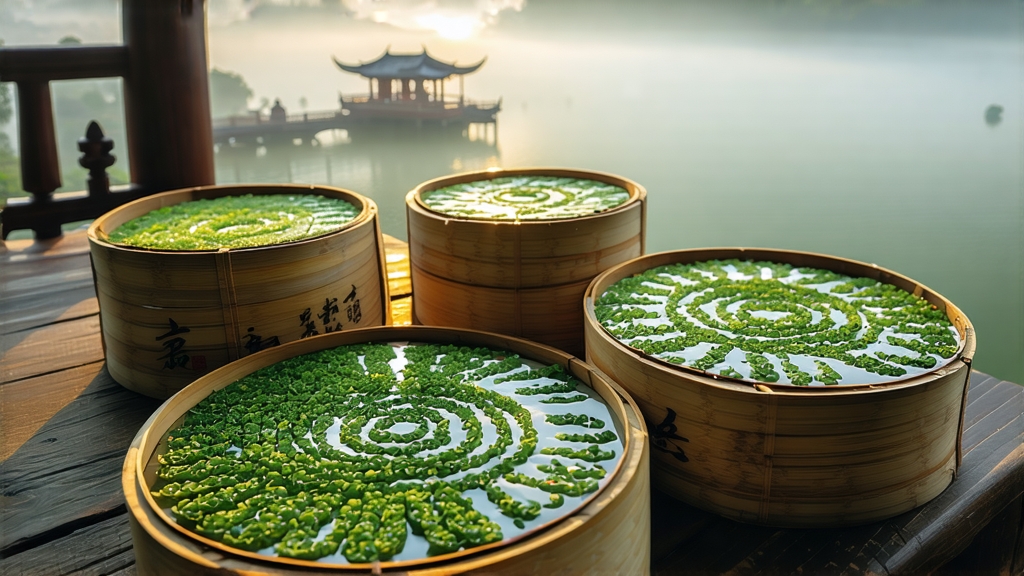
Biluochun, whose name literally means “Green Snail Spring,” is one of China’s ten most celebrated teas, yet it remains a quiet legend outside Asia. Grown on the mist-locked islands and peninsulas of Lake Tai in southern Jiangsu, this green tea is prized for the tight spiral each bud forms, a shape said to resemble a tiny jade snail curling inward on itself. To understand Biluochun is to listen to a 1,200-year conversation between water, rock, fruit blossom and human hand.
History whispers that the tea was first picked by Buddhist nuns on Dongting Mountain during the Tang dynasty. Originally called “Xia Sha Ren Xiang”—literally “Scary Fragrance” because its perfume was so startling—the leaf was later renamed by the Kangxi Emperor after he tasted it in 1699 and found the curled shape reminiscent of a snail shell picked in early spring. Court records describe the emperor insisting that the entire harvest be sent to Beijing within ten days of plucking, carried on horseback along the Grand Canal at night when temperatures were lowest, preserving the volatile aromatics that still define the tea today.
Unlike many Chinese greens that are now cultivated across several provinces, authentic Biluochun remains stubbornly local. The Chinese government has drawn a protective circle around only two tiny towns—Dongshan and Xishan—where the lake’s micro-climate traps morning mist until noon, diffusing sunlight and coaxing the bushes to produce extra amino acids that translate into sweetness. Within this zone, three sub-cultivars dominate: the small-leaf “Xiao Ye,” the aromatic “Fuding Da Bai,” and the rare purple-stemmed “Zi Ya.” Each brings a different accent to the cup, yet all must obey the same iron rules of seasonality: only the bud and the immediately adjacent leaf, plucked before the Qingming festival in early April, qualify for the top grade “Special One.”
The crafting of Biluochun is a ballet of heat, pressure and timing that unfolds in six acts. First, the freshly picked shoots are spread no thicker than two fingers on bamboo trays and left to breathe for two hours, allowing grassy volatiles to drift away. Next comes “sha qing,” or kill-green, performed on a cast-iron pan heated to 180 °C. The tea master tosses 250 grams of leaves with bare hands, a weight chosen because the human palm can judge temperature faster than any thermometer. After three minutes the temperature is dropped to 70 °C and the motion changes from flick to press; fingers curl the leaf around the palm, forming the signature spiral while rupturing just enough cell walls to release enzymes. This dual-temperature step lasts exactly nine minutes—one minute longer and the tea becomes dull, one minute shorter and it will sour within weeks. The leaves are then rolled on a rattan mat, screened to remove broken fragments, and finally dried over a charcoal brazier covered with thin rice paper, absorbing a faint sweetness from the burning bamboo. The entire process must finish before sunset the same day, a schedule unchanged since the Ming dynasty.
To brew Biluochun properly, one must first choose glass. Porcelain mutes the aroma, while clay competes with the tea’s own mineral notes. Use 3 grams of leaf for every 150 ml of water, but instead of pouring water onto the leaves, invert the ritual: drop the spirals into the glass first, then cool the water to 75 °C and let it slide down the inner wall. The buds drift like green comets before standing upright—a phenomenon locals call “the forest rising from the lake.” Steep for 45 seconds; the first infusion should be pale champagne gold with a nose of white peach and river stone. Second infusion, 30 seconds, brings out narcissus and a hint of salted plum. By the third, the cup tastes like rain on apricot blossoms, after which the leaves surrender and should be retired.
Tasting Biluochun is best done in silence. Hold the cup at eye level and observe the suspended down, the tiny hairs that detach from the bud and float like plankton under light. Inhale without sipping; the aroma should travel to the back of the throat before the liquid touches tongue. When you do sip, purse the lips slightly to draw air across the tea, atomizing the fragrance. A top-grade Biluochun will finish with a “gan” or returning sweetness that appears 30 seconds after swallowing, a cool sensation that starts at the tip of the tongue and migrates to the molars. If the aftertaste stops at the front of the